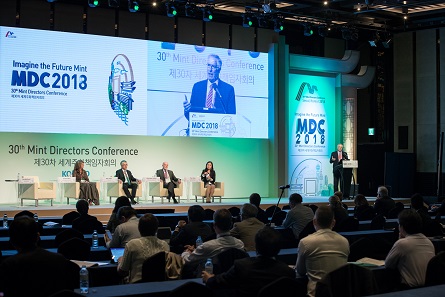by Ursula Kampmann
translated by Almuth Klingner
June 14, 2018 – While, in Panmunjom, Kim Jong-un and Moon Jea-in started a new chapter in the history of Korea, around 250 participants met in Seoul for the 30th Mint Directors Conference between April 22 and 26, 2018. Members of the mint industry from 36 nations were present, coming from central banks and mints, from suppliers, direct marketing companies, the media and coin conventions.
The hosts greet the more than 250 delegates from 36 nations. Photo: MDC 2018
The topics dealt with at the MDC show the current state of the community of the minting industry. Naturally, one issue was paramount:
The future of coins
For years, one topic has been dominating the first MDC session: What is the outlook for coins? Electronic payment transactions have become a lucrative branch over the last decade. The banks have long lost their monopoly on it. Private providers have established themselves and act aggressively and with low blows through the media against the proven means of payment, coins and banknotes.
The war against cash has been declared.
For the minting industry and its suppliers, winning this war is existential. Thus, two questions pose themselves:
1.) Does cash have a winning chance? Is it worth fighting the battle, or should we rather just give up now and use our good name to enter the virtual payment business ourselves?
2.) If there is a chance of winning the battle: How can the minting industry with its considerable resources take part in this “war” and fight for the preservation of coins?
The numerous talks held at the MDC provide a wealth of information. Photo: MDC 2018
The surprising resilience of cash
Not in a plenary session, but in a Marketing meeting, Claus Fischer presented an important talk by Helmut Stix, member of the Austrian National Bank. Using the example of Austria, he showed that the gloomy prophecies of the end of cash are not in line with reality. Currently, every Austrian citizen – from infant to elderly – is hoarding 3,000 euros in cash. That is certainly no small amount!
As a matter of fact, most major economies require more banknotes and coins each year.
In Austria, there has been no decrease in currency circulation since 2007. And those numbers are exemplary: In a total of 72 economies, currency circulation since 2003/04 has increased on average by 17%. Other business sectors would be happy to experience such growth rates!
This number, however, has to be viewed with caution. First and foremost, it reflects that many visitors from the neighboring countries take Austrian euros home with them as savings. Plus, in a low-interest environment, it is not worth taking money to the bank, which might be another reason for this large number.
The central banks and their clever mathematicians are quite surprised that the demand for cash is still growing, even though the statistics clearly show that the shadow economy continues to shrink. Some of them consider the financial crisis of 2008 as an explanation for the current upsurge of cash. They draw parallels to the economic depression of the 1930s which had also raised the bank note circulation.
The fact is, cash is not just hoarded, but still plays a role in everyday payments, especially for small amounts. However, the use of cash is lower the higher the market player’s level of education.
In short: A change can be perceived, but it is happening extremely slowly.
Cash logistics as development driver
In his presentation, Ron Delnevo, representative of the ATM industry which would also suffer significantly from the disappearance of cash, demonstrated the impact of deploying and removing ATMs on cashless payments. Especially nations where long distances have to be bridged in order to restock ATMs experience a decrease in numbers. Private banks are less and less willing to cover the costs of logistics needed to provide the citizens with cash. Sweden is a current example, propagating the cashless society for financial reasons, and mainly driven by the commercial banks.
Ron Delnevo didn’t stop at the problem, but presented an alternative, using the example of the Australian community Cummins. Australia, too, is one of those countries with a sparse population and long distances between the settlements. The community of Cummins decided to ensure the citizens‘ cash supply by founding its own microbank, using the citizens’ funds. Its structure is reminiscent of the first Raiffeisen banks: In 2000, every citizen invested on average 1,500 pounds for the opening of the microbank. Thus, the people of Cummins continue to have a bank branch providing them with cash. By now, this microbank is making good profits.
Possibilities of the minting industry?
It was a rather gloomy picture that Pak Ling Yip, director of the Singapore Mint, drew of the possibilities that are left to the minting industry regarding this development. He recommended, in the first place, to stand by as a secure alternative for central banks in case of the eventual demonetization of coins. Second, he advised that mints join the cashless payment movement themselves and boost the sale of commemorative coins.
The coin/banknote boundary or How many countries should replace a banknote with a coin
Simon Lake is taking a different approach. For some time now, he has been adamantly pushing for lobbying the world’s central banks at the expense of the banknote industry to raise the value boundary between coins and banknotes: Nowadays, 74 nations have banknotes with a value below 50 US cents. 46 nations use banknotes valued at less than 20 US cents, and 24 nations such at less than 5 (!) US cents. 9 nations of the world even have a banknote in circulation that is worth less than one (!) US cent. And 12 nations use no coins at all in their payment system.
Since coins are significantly superior to banknotes as regards cost structure, it would be high time for taking action and reversing the trend. Between 7 and 21 African nations should replace a banknote with a coin, in Asia, the number lies between 16 and 34, in the Americas between 5 and 20, in Europe between 5 and 28, depending on how you calculate the coin/banknote boundary.
Unfortunately, the central banks do not agree. Over the past 24 months, only 3 nations have replaced a banknote with a coin. 5 nations, on the contrary, have demonetized low value coins in the same period.
Simon Lake calls for collaboration in order to convince central banks all over the world that coins are the better option. His proposition has gained quite a number of followers. Others, however, are critical towards his fight against the paper money industry.
They wonder if it wouldn’t be better to fight together with the quite influential banknote lobby for the preservation of cash. Especially those mints that are integrated in an institution that also deals with security printing want to avoid an internal dispute.
It is in fact a strategic question whether a common position of the MDC can or perhaps cannot be found on this topic.
In the next part, we will cover the new handbooks and guidelines issued for mints.
Here, you get to the website of the MDC 2018.
The Mint Directors Conference has a new website.
The MDC2018 was organized by KOMSCO, die Korea Minting, Security Printing & ID Card Operating Corporation.
On this website, you can find out more about KOMSCO.





